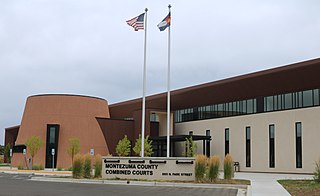
Montezuma County is the southwesternmost of the 64 counties in the U.S. state of Colorado. As of the 2020 census, the population was 25,849. The county seat is Cortez.

The City of Cortez is the home rule municipality that is the county seat and the most populous municipality of Montezuma County, Colorado, United States. The city population was 8,766 at the 2020 United States Census.

The Town of Mancos is a Statutory Town located in Montezuma County, Colorado, United States. The town population was 1,336 at the 2010 United States Census.

Montezuma Castle National Monument protects a set of well-preserved dwellings located in Camp Verde, Arizona, which were built and used by the Sinagua people, a pre-Columbian culture closely related to the Hohokam and other indigenous peoples of the southwestern United States, between approximately 1100 and 1425 AD. The main structure comprises five stories and about 20 rooms and was built over the course of three centuries.

The Sinagua were a pre-Columbian culture that occupied a large area in central Arizona from the Little Colorado River, near Flagstaff, to the Verde River, near Sedona, including the Verde Valley, area around San Francisco Mountain, and significant portions of the Mogollon Rim country, between approximately 500 CE and 1425 CE.

McPhee Reservoir is located in Montezuma County, Colorado, United States. It was constructed and is operated by the United States Bureau of Reclamation as part of the Dolores Project, and dams the Dolores River to furnish irrigation water for Montezuma and Dolores counties and the Ute Mountain Ute Indian Reservation.
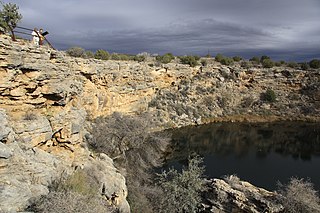
Montezuma Well, a detached unit of Montezuma Castle National Monument, is a natural limestone sinkhole near the town of Lake Montezuma, Arizona, USA, through which some 1,500,000 US gallons of water emerge each day from an underground spring. It is located about 11 miles (18 km) northeast of Montezuma Castle.

Pleasant View is an unincorporated community and a U.S. Post Office located in Montezuma County, Colorado, United States. The Pleasant View Post Office has the ZIP Code 81331.
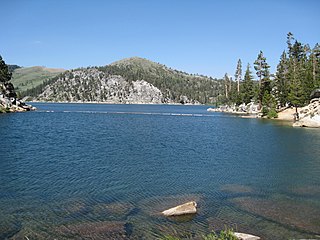
The Marlette Lake Water System was created to provide water for the silver mining boom in Virginia City, Nevada. These structures are now listed as a National Historic Civil Engineering Landmark by the American Society of Civil Engineers, and are also listed on the National Register of Historic Places. The listed area included two contributing buildings and 12 contributing structures on 135.4 acres (54.8 ha). It has also been known historically as the Virginia and Gold Hill Water Company Water System.

William Baltzell Ebbert was an officer and adjutant in the Union Army, a Colorado legislator, newspaper publisher, author, farmer, businessman, and poet. Ebbert published the Pueblo Review and Standard newspaper in 1890, authored the landmark meat inspection legislation in Colorado in 1889 and battled with Prohibitionists in the 1910s. As a Director of the Montezuma Valley Irrigation District from 1911 to 1920, he guided the district through turbulent times and helped engineer its dissolution and reemergence as the Montezuma Valley Irrigation Company in 1920.
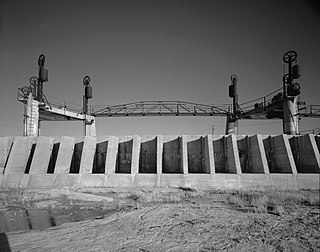
The Carlsbad Irrigation District, also known as Carlsbad Reclamation Project or Irrigation system of the Pecos Irrigation and Improvement Company, is a major early water reclamation project located near Carlsbad in southeastern New Mexico. Begun in the 1880s, it is now managed by the United States Bureau of Reclamation, and provides irrigation water to a large area around Carlsbad, diverted from the Pecos River and the Black River. The late 19th and early 20th-century elements of the project were designated a National Historic Landmark District in 1964.

The Brooks Aqueduct is a defunct aqueduct, historic site and museum originally built by the irrigation division of the Canadian Pacific Railway Company during the early 1910's located in Southern Alberta, Canada. The aqueduct was intended to irrigate a section of southeastern Alberta by diverting water east from Lake Newell from 1914 to 1979, and is located approximately 8 kilometres south of the City of Brooks. The main section of the aqueduct spans a 3.2 km valley at an average elevation of 20 metres. The structure has been designated a National Historic Site with an interpretive centre constructed nearby for tourists.

The historical buildings and structures of Zion National Park represent a variety of buildings, interpretive structures, signs and infrastructure associated with the National Park Service's operations in Zion National Park, Utah. Structures vary in size and scale from the Zion Lodge to road culverts and curbs, nearly all of which were designed using native materials and regional construction techniques in an adapted version of the National Park Service Rustic style. A number of the larger structures were designed by Gilbert Stanley Underwood, while many of the smaller structures were designed or coordinated with the National Park Service Branch of Plans and Designs. The bulk of the historic structures date to the 1920s and 1930s. Most of the structures of the 1930s were built using Civilian Conservation Corps labor.

The Crow Creek Water Ditch is a historic water transportation system which brought water from Eureka Creek to where it was needed in gold placer mining in the Indian Creek drainage area where gold was discovered in 1866. It is located near Townsend, Montana. It was built between 1866 and c.1875 originally to support gold mining, which required water, then later was used for farm and ranch irrigation.

Avalon Dam is a small dam on the Pecos River about 5 miles (8.0 km) north of Carlsbad, New Mexico, United States. The dam is a storage and regulating reservoir, and diverts water into the main canal of the Carlsbad Project, an irrigation scheme.

The Percha Diversion Dam is a structure built in 1918 on the Rio Grande in New Mexico, United States. It diverts water from the Rio Grande into the Rincon Valley Main Canal, an irrigation canal.
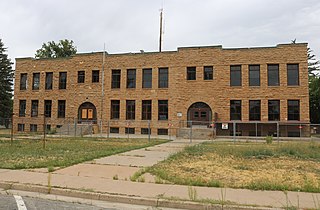
Cortez High School, at 121 E. First St. in Cortez, Colorado, was built in 1909 and operated as a school until 1968.

The Montezuma Valley National Bank and Store Building, at 2-8 Main St. in Cortez, Colorado, was built in 1909. It was listed on the National Register of Historic Places in 2009.


















